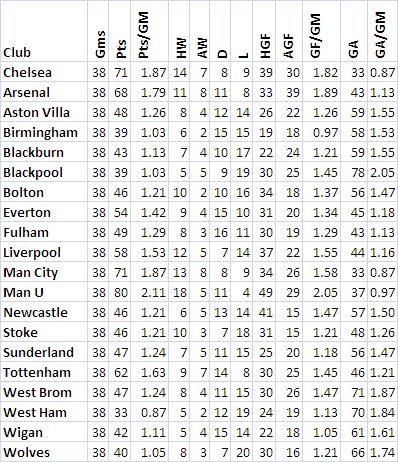
As the table above reveals, the most productive player in the MLS this season, at least in terms of sheer offensive production per game (Min Played/90), is Jeff Cunningham of FC Dallas. Our own Willie Schelotto is fifth per game but tops in terms of OVERALL production for the entire season. Take away Cunningham's four goals last weekend and he drops out of number one but stays in the top 10. Obviously, that game could be a fluke, but we have to stay true to the numbers our little black boxes give us.
Speaking of which, the Luchametric Player rankings are based on a weighted metric that takes several variables into account. After a complete review of the 2008 season and the 2009 season through the All-star break, it’s become apparent that on average the league’s leading offensive players score about .14 goals for every shot taken, and about .34 goals for every Shot on Goal. These numbers were arrived at by looking at players who scored at least one goal during the 2008 season and who played a minimum of 1300 minutes or were below the 1300 minute minimum but scored at least five goals (one goal above the league average for scorers for that year). We then included the top 30 goal scorers from 2009. These averages mean that among goal scorers, or among players most likely to participate in a scoring opportunity regularly (players whose job it is to contribute offensively), such players score 14% of the time when they shoot, or 34% of the time when they manage to put a shot on goal. Players (and by extension, teams) who generate more scoring opportunities and convert them at a better rate are better on the offensive side of the ball than others (duh).
Accordingly, it’s possible to start measuring something we’ll call Offensive Production, or each player’s offensive contribution to his team, as follows:
Offensive Production = Goals + Assists + (.34xSOG) + (.14SHT)
This formula gives us a raw number to use for comparison, taking into account not only successful scoring chances (Gs and As) but also every opportunity each player participated in. Note that assists are in fact goals (or they wouldn’t count as assists), and that we’re factoring in SHTs and SOGs as well because we want to get a sense not only of the sheer number of goals contributed by a player (G ), but also how many goal scoring opportunities a player has created or participated in via either an assist (A) or a shot, especially a SOG. But clearly, neither a SHT nor a SOG is worth as much as a goal or an assist, so we count them but weight them differently. Remember, we want a measure of how productive a player is, not simply how successful he is. Goals are the result, but we know that great players create opportunities for themselves and others that don’t show up as Gs in the box score.
Further, we know that scorers will get more opportunities to score and thus more SHTs and SOGs by virtue of being the principal targets for their respective teams’ midfielders and defenders. So, we also want to factor in how much more efficient they are than other scorers. We can do this by determining how good they are at turning SHTs and SOGs (which are a measure of not only their own prowess but also of their team’s ability to get them the ball) into Gs. We can do this by adding in the actual percentage of SHTs and SOGs that a player in fact turned into a goal multiplied by the average number of SHTs and SOGs a scorer in the league typically takes. Now our formula gets a little more complicated:
Offensive Production = [(Goals + Assists + (.34SOG) + (.14SHT)+ (Player G/SHT% * league AVG SHTs)+(Player G/SOG%*League Avg SOGs)
Now we have a formula that credits how many Gs the player scored; how many As they achieved; how many SHTs they participated in; how many SOGs they participated in; AND how good or EFFICIENT they were at converting SHTs and SOGs to Gs. These additional variables are important because the difference between an average striker in any league and a truly great striker (Etoo comes to mind) is that the latter are DEADLY. Give them an opportunity to score, and they will convert a far greater percentage of those opportunities than will anyone else. But we're not done.
Finally, we have noticed that the league's top producers also have a much higher percentage of SOGs relative to SHTs. How many times have you watched a player get a perfectly played ball and then blast it over the top of the goal or far wide or just plain muff it? Well, the numbers tell us that great players don't do that nearly as much. Among the leagues LEADING scorers (not just everyone), the average % of SHTs turned into SOGs is 44% (for all players who take SHTS it is much less). So, we add one more variable:
Finally, we have noticed that the league's top producers also have a much higher percentage of SOGs relative to SHTs. How many times have you watched a player get a perfectly played ball and then blast it over the top of the goal or far wide or just plain muff it? Well, the numbers tell us that great players don't do that nearly as much. Among the leagues LEADING scorers (not just everyone), the average % of SHTs turned into SOGs is 44% (for all players who take SHTS it is much less). So, we add one more variable:
(Player's SOG% *(league avg number of SOGs))*.34
Remember that the league average for SOGs becoming Gs is .34, so we're simply giving a player credit for efficiency relative to the league average. This tells us how many MORE goals than average a player scores due to the fact that he is a more efficient converter of SHTs to SOGs. The final metric looks like this:
Offensive Production = [(Goals + Assists + (.34SOG) + (.14SHT)+ (Player G/SHT% * league Avg SHTs)+(Player G/SOG%*League Avg SOGs)+(Player's SOG% *league avg number of SOGs)*.34))
This gives us a raw number telling us how productive a player has been overall. We then divide that number by games played (number of minutes played/90) and we get the Luchametric Player Pro/GM rating.
In the above table, Cunningham is the highest ranked player PER GAME. But in terms of sheer production, it's our very own Willie Schelotto. Well done my son. The force is strong with you.









 The Luchametric is a
The Luchametric is a 


















1 comment:
That's awesome. A lot of work must have gone into setting that up.
Post a Comment